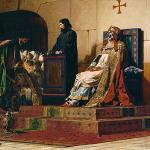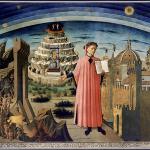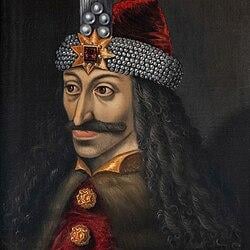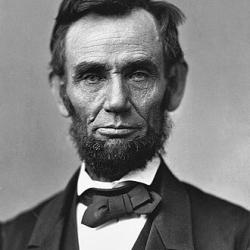11th Century
11th century: c. 1000 – 1100 – Oxford Reference
Popes 140 – 160 had their pontificates in this time period.
2 Saint Popes
2 Blessed Pope
17 Non-Sainted Popes
4 Anti – Popes
Why is it that we mainly remember the Middle Ages by absurd things? When we talk of something medieval, we mean something quaint. We remember that alchemy was medieval, or that heraldry was medieval. We forget that Parliaments are medieval, that all our Universities are medieval, that city corporations are medieval, that gunpowder and printing are medieval, that half the things by which we now live, and to which we look for progress, are medieval. —G. K. Chesterton1
No one living in the eleventh through the fourteenth centuries believed they were in the “Middle Ages.” The use of time periods to define history often produces raucous debate within the scholarly community. The story of the Church during these “glory years” is one of intense faith, grandiose adventures, and brilliant advancements in human achievement.
Steve Weidenkopf, The Church and the Middle Ages (1000–1378)(2020) Cathedrals, Crusades, and the Papacy in Exile (Reclaiming Catholic History) Ave Maria Press.
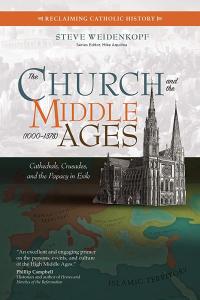
c. 1000–1025 – The only surviving manuscript of Beowulf is written. This epic fantasy poem was a great influence for Lord of the Rings creator J.R.R. Tolkien. Tolkien’s long-awaited prose translation (edited by his son Christopher) was published in 2014 as Beowulf: A Translation and Commentary. The book includes Tolkien’s own retelling of the story of Beowulf in his tale Sellic Spell, but not his incomplete and unpublished verse translation.
In 2007 Beowulf became an American animated fantasy action film produced and directed by Robert Zemeckis, and written by Neil Gaiman and Roger Avary with a very big and talented cast which included Anthony Hopkins and Angelina Jolie.
LEARN MORE...Classics Summarized: Beowulf – YouTube
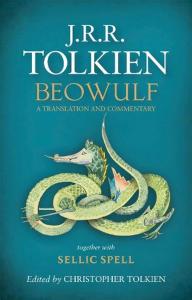
The Shield Ring (1956) by Rosemary Sutcliff is a historical novel for children. It is the last in a sequence of novels, chronologically started with The Eagle of the Ninth, loosely tracing a family of the Roman Empire, then Britain, and finally Norse-Britain, who inherit an emerald seal ring bearing the insignia of a dolphin. This story takes place in the 11th Century.
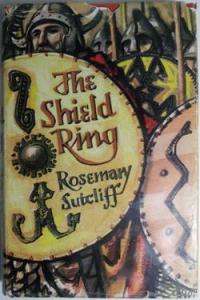
Faraway Princess (1962) by Jane Oliver. This book is The Adventures Of Three Royal Hungarian Children Who Were Summoned To The Anglo-Saxon Court Of King Edward The Confessor Just Before The Norman Conquest Of England.
1001: In later centuries I will write a lot about American history. It starts here at the beginning of the 2nd millennium. A group of Norsemen, led by Eric the Red’s son Leif Eriksson, establish short-lived settlements in and around Vinland in North America.
LEARN MORE… Leif Eriksson – The First European in North America – YouTube
1001–1008: Japanese Lady Murasaki Shikibu writes The Tale of Genji. It is considered the world’s first novel. It has been adapted several times into theater and film including the 1951 movie The Tale of Genji by Kōzaburō Yoshimura. You can even visit The Tale of Genji Museum is in Uji, Kyoto, Japan where you can explore the world of the novel.
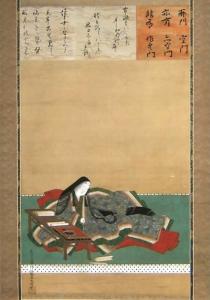
Murasaki Shikibu, illustration by Tosa Mitsuoki
who created a series of illustrations of
The Tale of Genji (17th century)
Learn More… What’s the Tale of Genji? – YouTube
June 21, 1002 – Pope # 152 St. Pope Leo IX (d. 1054) is born.
May 12, 1003 – Pope # 139 Non-Saint Sylvester II (April 2, 999 – May 12, 1003 – 4 years, 40 days) was the first French pope. He died after a 4-year pontificate. He is said to be the first in Europe to introduce the decimal numeral system using the Hindu-Arabic numeral system. He is also credited with the invention of the first mechanical clock in 996.He is succeeded by John XVII as the 140th pope of the Catholic Church.
November 6, 1003 – Pope # 140 Non- Saint John XVII (May 16, 1003 – November 6, 1003 –
174 days) dies after a pontificate of about 7 months and is buried in the Lateran Basilica at Rome.
1007 – The Book of Kells is probably stolen from the Abbey of Kells in Ireland for several months.
LEARN MORE… The astonishing Book of Kells – YouTube
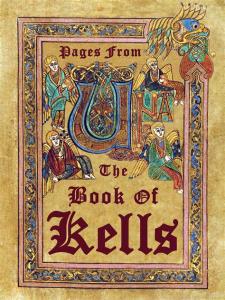
The Book of Kells, Co. Dublin (from-ireland.net)
October 18, 1009 – The Church of the Holy Sepulchre in Jerusalem is destroyed by the Fatimid caliph Al-Hakim bi-Amr Allah. This church also known as the Church of the Resurrection, is considered to be the holiest site for Christians in the world, as it has been the most important pilgrimage site for Christianity since the 4th century. The church is home to two of the holiest sites in Christianity – the place where Jesus was crucified, known as Calvary, and the tomb where Jesus was believed to have been buried and then resurrected.
1020’s – The earliest-known outbreak of dancing mania occurred in the 7th century, and it reappeared many times across Europe until about the 17th century, when it stopped abruptly. One of the earliest-known incidents occurred sometime in the 1020s in Bernburg, where 18 peasants began singing and dancing around a church, disturbing a Christmas Eve service.
Learn More… The Plague That Made People Dance Themselves to Death – YouTube
1025 – The Canon of Medicine is an encyclopedia of medicine in five books compiled by Muslim Persian physician-philosopher Avicenna and completed in 1025.
1027 – The Truce of God, first proclaimed in 1027 at the Council of Toulouges, attempted to limit the days of the week and times of year that the nobility engaged in violence. The movement survived in some form until the thirteenth century.
1027 – The Book of Healing is a scientific and philosophical encyclopedia written by Abu Ali ibn Sīna (also known as Avicenna) from medieval Persia, near Bukhara in Maverounnahr. He most likely began to compose the book in 1014, completed it around 1020, and published it in 1027.
1027–1028 – In wide-ranging negotiations between the Fatimids and the Byzantine Empire an agreement was reached whereby the new Caliph Ali az-Zahir (al-Hakim’s son) agreed to allow the rebuilding and redecoration of The Church of the Holy Sepulchre.
Learn More.…Ascension Presents Holy Sepulchre – YouTube
So far literature without a printing press is doing quite well. Trying to find music and art and TV shows in this time period are a little harder to find in my research. But I did come across “Virtutues Instrumenti” which is based on 11th century sacred music. These pieces carry melodies only, and no words.
And now for some real drama.
The Pontificate of Benedict IX
If you really thought a certain pope was bad and the worst of the worst then meet B the 9th.
October 21, 1032 –Pope # 145 Non-Saint Benedict IX (October 21, 1032 – December 31 1044-
12 years, 71 days) succeeds his uncle Pope # 144 John XIX (May 14, 1024 – October 6, 1032 –
8 years, 145 days) after he dies which is after an 8-year pontificate at Rome. He was (probably) still in his teens. His ascension to the papacy was his first reign (yes you read that right) as pope. He is one of the youngest popes in history. He is also the only person to have been Pope more than once and the only person ever accused of selling the papacy.
Pope Benedict IX surely must be considered a contender for Worst Pope in History. The Catholic Encyclopedia calls him a “disgrace to the Chair of Peter.” He is the only man to hold the office of the papacy on multiple occasions. He left the papal office not once, not twice, but three times!
–Eric Sammons, On Deposing Popes: A Historical Review (October 9, 2018)OnePeterFive
1040 – The Wujing Zongyao sometimes rendered in English as the Complete Essentials for the Military Classics, is a Chinese military compendium written from around 1040 to 1044. It contains the earliest known written chemical formulas for gunpowder, made from saltpeter, sulphur and charcoal along with many added ingredients.
After c. 1040 – Le Chanson de Roland (The Song of Roland), original version, perhaps by Turold is written. based on the Frankish military leader Roland at the Battle of Roncevaux Pass in AD 778, during the reign of the Carolingian king Charlemagne. It is the oldest surviving major work of French literature. It exists in various manuscript versions, which testify to its enormous and enduring popularity in Medieval and Renaissance literature from the 12th to 16th centuries. In 2019, German folk rock band dArtagnan released “Chanson de Roland”, a modern adaptation of the Song of Roland. It has garnered over 1.8 million views on YouTube.
June 8, 1042 – King Harthacnut collapses while attending a party. He dies without an heir, Saint Edward the Confessor becomes king of England. He was an Anglo-Saxon English king and saint. Usually considered the last king of the House of Wessex, he ruled from 1042 until his death in 1066.
Back To The Drama of B9
September 1044 – He was accused by Dr. St. Peter Damian in his Liber Gomorrhianus of routine sodomy and bestiality and sponsoring orgies. Opposition to Benedict IX’s dissolute lifestyle forced him out of the city. He is succeeded by the new elected (anti)-Pope Sylvester III (until 1045). Though some consider him to have been an antipope, Sylvester III continues to be listed as an official pope (1045) in Vatican lists.
January 20, 1045 – Pope Sylvester III becomes the 146th non-saint pope, succeeding Benedict IX, who abdicated during the previous year.
February, 1045– Pope Sylvester III is deposed (election deemed invalid); Pope Benedict IX is elected once more, becoming the 147th pope (March 10, 1045 – May 1, 1045 – 52 days).
May 5, 1045 – Pope Gregory VI becomes the 148th non-saint pope (May 5, 1045 – December 20, 1046 –
1 year, 229 days), following the resignation of Pope Benedict IX in exchange for money. There are growing allegations that simony is taking place during Gregory VI’s reign.
Summer 1046 – Although Pope Gregory is the true pope at this time, it didn’t stop Ex-Pope Benedict IX from trying to take back the chair of Peter. Sylvester III once again reasserts his claim.
December 20 , 1046– Pope Gregory VI is accused of simony at the Council of Sutri, and abdicates as pope of the Catholic Church. Benedict IX and Sylvester III were also declared deposed.This all happened because Emperor Henry III interfered.
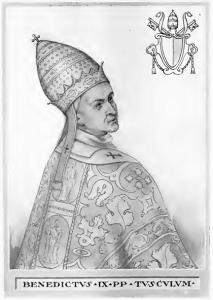
Illustration of Benedict IX originally published in 1842, modeled after a contemporary depiction of Benedict from c. 1030
December 25 , 1046 – Pope Clement II succeeds Gregory VI as the 149th non-saint pope (December 24, 1046 – October 9, 1047 – 289 days), and crowns Henry III as Holy Roman Emperor.
October 9, 1047 – Pope Clement II dies suddenly after a 9-month pontificate. He is succeeded once again by Benedict IX as the 150th pope (November 8, 1047 – July 17, 1048 – 252 days)
July 16, 1048 – At orders of Henry III, German troops under Boniface III (Canossa), enter Rome and expel Pope Benedict IX.
July 17, 1048 – Pope Damasus II succeeds Benedict IX as the 151st pope (July 17, 1048 – August 9, 1048 – 23 days), but he dies after 23 days.
December, 1048– Bruno von Egisheim-Dagsburg, bishop of Toul, is selected as pope # 152 February 12, 1049 – April 19, 1054 – 5 years, 66 days) by an assembly at Worms – after canonical election in Rome next February, he assumed the name Leo IX who after the last bunch of Popes manages to become a Saint.
February 12, 1049 – Pope St. Leo IX finally succeeds Damasus II. One of his first ventures as Pope has him going on a one-year trip to promote the cause of the reformist program among the European prelates.
Dr. St. Peter Damian’s opinion on Sexual Abuse
Any cleric or monk who seduces young men or boys, or who is apprehended in kissing or in any shameful situation, shall be publicly flogged and shall lose his clerical tonsure. Thus shorn, he shall be disgraced by spitting in his face, bound in iron chains, wasted by six months of close confinement, and for three days each week put on barley bread given him toward evening. Following this period, he shall spend a further six months living in a small segregated courtyard in custody of a spiritual elder, kept busy with manual labor and prayer, subjected to vigils and prayers, forced to walk at all times in the company of two spiritual brothers, never again allowed to associate with young men.
Letter 31:38. To Pope Leo IX, A.D. 1049.
The Fathers of the Church, Medieval Continuation, Peter Damian: Letters 31-60, Owen J. Blum, tr., Catholic University of America Press, ISBN 081320707X ISBN 9780813207070, vol. 2, p. 29.[1]
Whew! What a Ride.
Now it’s time for some 11th Century Calm Art.

Fishermen’s Evening Song (detail), one of Xu Daoning’s most famous paintings, located in the Nelson-Atkins Museum in Kansas City, Missouri circa 970 – 1051/53.
April 19, 1054 – St. Pope Leo IX (June 21, 1002 – April 19, 1054) dies.
July 4, 1054 (approx.) – a supernova, is first observed by the Chinese, Arabs and possibly Native Americans, near the star Zeta Tauri. For 23 days it remains bright enough to be seen in daylight. Its remnants form the Crab Nebula (NGC 1952)
We’re half way through the century and we now come to the event that rocks the church and splits it in two.
1054 The Great Schism
July 16, 1054 – East-West Schism: Humbert of Silva Candida, representative of the newly deceased Leo IX, breaks the relations between Western and Eastern Churches, through the act of placing an invalidly-issued Papal Bull of excommunication during the celebration of the Divine Liturgy. There is not pope on the throne of Peter at this time. Their won’t be another pope until non-saint Pope # 153 Victor IIApril 13, 1055 – 28 July 28, 1057 – 2 years, 106 days)
September 24, 1054 – Blessed Hermann of Reichenau or Herman the Cripple (July 18 – 1013 – September 24, 1054), dies. He was an 11th-century Benedictine monk and scholar. He composed works on history, music theory, mathematics, and astronomy, as well as many hymns. He has traditionally been credited with the composition of “Salve Regina“, “Veni Sancte Spiritus“, and “Alma Redemptoris Mater“, although these attributions are sometimes questioned. His cultus and beatification were confirmed by the Roman Catholic Church in 1863.
1056 – The scandalous Pope Benedict IX’s eventual fate is obscure, but he seems to have given up his claims to the papal throne. Leo IX may have lifted the ban on him. Benedict IX was buried in the Abbey of Grottaferrata c. 1056. According to the abbot, Saint Bartholomew of Grottaferrata, he was penitent and turned away from the sins he committed as pontiff.
July 28, 1057 – Pope Victor II dies after a 15-month pontificate at Arezzo. He is succeeded by Non-Saint Stephen IX as the 154th pope (August 2, 1057 – March 29, 1058 – 239 days)
January 24, 1059 – Non-Saint Pope Nicholas II succeeds Stephen IX as the 155th pope (December 6, 1058 – July 27, 1061 – 2 years, 233 days) He is installed in Rome in opposition to Antipope Benedict X – the brother of the late Pope Benedict IX (deposed in 1048).
April 13, 1059 – Nicholas II, with the agreement of the Lateran Council, issues the papal bull In nomine Domini, making the College of Cardinals the sole voters in the papal conclave for the election of popes.
1061–Our Lady of Walsingham Richeldis de Faverches was a devout English Christian noblewoman who had a series of three visions in which the Virgin Mary appeared to her. In these visions Richeldis was shown the house of the Annunciation in Nazareth and was told to build a replica of the house in Walsingham as a place of pilgrimage where people could honour the Virgin Mary. Mary is said to have promised, “Whoever seeks my help there will not go away empty-handed.”
Learn More… The Mystery of Walsingham – Our Lady’s Holy House Foundation – YouTube
March 20, 1066 – Halley’s Comet reaches perihelion. The comet was seen in England and thought to be an omen: later that year Harold II of England died at the Battle of Hastings and William the Conqueror claimed the throne. The comet is represented on the Bayeux Tapestry and described in the tituli as a star.
September 27, 1066 – William, Duke of Normandy and his army set sail from the mouth of the River Somme, beginning the Norman conquest of England. The following day he lands on the English coast at Pevensey, splits his forces, and sails with the main army to Hastings.
October 14, 1066 – At the Battle of Hastings King Harold II of England was defeated by the invading Norman forces of William the Conqueror. By the end of the bloody, all-day battle, Harold was dead and his forces were destroyed. Harold was the last Anglo-Saxon king of England, and the battle changed the course of history and established the French-speaking Normans as the new rulers of England, which in turn brought about a significant cultural, economic and military transformation, and helped to create the modern English language. Battle of Hastings: Facts, Date & William the Conqueror | HISTORY
August 26, 1071 – Battle of Manzikert:
The Byzantine Empire was the successor to the Roman Empire and ruled a large area in Europe and the Middle East. Byzantine played a major role in the Balkans and Russia, and it successfully kept the Arabs and the Muslims out of Europe for centuries. In 1071 the Empire seemed invincible. It had reversed many years of decline under a series of energetic Emperors. It had recovered territory lost to its enemies and had morphed into a powerful political and military force.
The Battle of Manzikert fundamentally reversed this upward trend and led to the decline of the Byzantine Empire. As Byzantine collapsed, Turkish Muslims gradually gained control of Asia Minor. As Muslims took control of the Christian holy lands, European countries responded by launching the Crusades. The Battle of Manzikert is one of the most important in medieval history, and its repercussions can still be felt today. How did the battle of Manzikert (1071) change the Byzantine Empire – DailyHistory.org
February 22, 1072 – Death of St. Dr. Peter Damian (c. 1007 – 21 or 22 February 1072 or 1073). He was was an Italian reforming Benedictine monk and cardinal in the circle of St. Pope Leo IX. Dante placed him in one of the highest circles of Paradiso as a great predecessor of Francis of Assisi and he was declared a Doctor of the Church on September 27, 1828. His big contribution to theology was De Divina Omnipotentia, a long letter in which he discusses God’s power.
April 21, 1073 – Pope Alexander II dies after a 11½-year pontificate at Rome. He is succeeded by Pope # 157 Non-Saint Gregory VII (April 22, 1073–May 25, 1085 – 12 years 33 days.
April, 1075 – The Dictatus papae (a compilation of 27 statements of powers) are included in the registry of Gregory VII, in which he asserts papal authority over earthly as well as spiritual rulers.
December 25, 1075 – Gregory VII is kidnapped in the church during Christmas night in Rome and briefly imprisoned by the Roman nobleman Cencio I Frangipane.
January 25, 1077 – Walk to Canossa: Emperor Henry IV travels to the Castle of Canossa near Reggio Emilia (Northern Italy), to visit Pope Gregory VII. He waits (with his wife Bertha of Savoy and son Conrad) at the gates for three days, for absolution of his excommunication. Gregory lifts the sentence, imposing on Henry a vow to comply with certain conditions
1077 – 1078 – The Proslogion by Dr. St. Anselm of Canterbury is written. The book contains the famous theological/ philosophical ontological argument for God. He defines God as “a being than which no greater can be conceived,” and argues that such a being must exist in the mind, even in that of the person who denies the existence of God. From this, he suggests that if the greatest possible being exists in the mind, it must also exist in reality, because if it existed only in the mind, then an even greater being must be possible—one who exists both in mind and in reality. Therefore, this greatest possible being must exist in reality. He was declared a doctor of the church in 1720.
Learn More… Anselm & the Argument for God: Crash Course Philosophy #9 – YouTube

Cui Bai – Magpies and Hare (fl. 1050–1080)
1084 – Pope Gregory VII, who is imprisoned by Henry IV in Castel Sant’Angelo, is freed by Robert Guiscard. He restores papal authority in Rome.
1088 – The oldest extant university, the University of Bologna, is founded in Italy (approximate date).
1084 – St. Bruno of Cologne founds the Carthusian Order which includes both monks and nuns. He builds an hermitage in the French Alps.
May 1094 – Rodrigo Diaz, known as El Cid, drives out the Muslims and wins Valencia
The Age of Crusades Begins
November 18, 1095 – The Council of Clermont begins. The synod is called by Pope # 159 Bl. Urban II (March 12, 1088 – (July 29, 1099
– 11 years, 139 days)to discuss sending the First Crusade to the Holy Land.
November 27, 1095 – Urban II preaches the First Crusade at the Council of Clermont; Peter the Hermit begins to preach throughout France.
November 28,1095 – Urban II appoints Bishop Adhemar of Le Puy and Count Raymond IV (Saint-Gilles), to lead the First Crusade.
1096 – The first documented teaching at the University of Oxford in England occurs.
The First Crusade (1096–1099)
This was the first of a series of religious wars, or Crusades, initiated, supported and at times directed by the Latin Church in the medieval period. The objective was the recovery of the Holy Land from Islamic rule.
Learn More… The Crusades – Pilgrimage or Holy War?: Crash Course World History #15 – YouTube
1099 – Blessed Gerard Sasso (c. 1040 – September 3, 1120), was a lay brother in the Benedictine Order who was appointed as rector of the hospice in Jerusalem at Muristan in 1080. In the wake of the success of the First Crusade in 1099, he became the founder of the Order of St John of Jerusalem, also known as the Knights Hospitaller, an organization that received papal recognition in 1113. As such, he was the first Grand Master of the Knights Hospitaller.
We leave the first century of the 2nd millennium with this…
1099 – The Liberation of Jerusalem is achieved by crusaders.
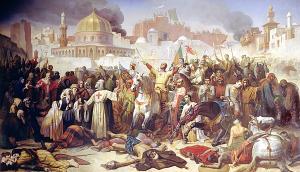
Émile Signol (1847)
And Now we move on to the next century…
12th Century
12th century: c. 1100 – c. 1200 – Oxford Reference
Popes 161 – 176 reigned as supreme pontiff.
0 Saint Popes
1 Blessed Pope
15 Non-Sainted Popes
10 Anti – Pope
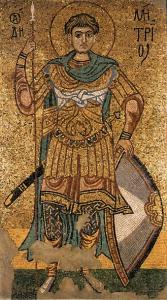
Unknown, Saint Demetrius of Thessaloniki, c. 1113
1115 – Clairvaux Abbey is founded by St. Bernard, French abbot and a major leader in the reform of Benedictine monasticism, in France.
1115 – Peter Abelard is often referred to as the “Descartes of the twelfth century”. Philosopher Pete is considered a forerunner of Rousseau, Kant, and Spinoza. He is sometimes credited as a chief forerunner of modern empiricism. He was teaching philosophy at Notre Dame until an affair with one of his pupils, Héloïse, brought his career to a dramatic end.
Learn More… PETER ABELARD – The Man Behind the Famous Love Story of Heloise and Abelard – YouTube
1119 -Autumn – Hugh de Payns founds the monastic order of the Knights Templar and becomes the first Grand Master. In association with Bernard of Clairvaux, a French abbot and religious leader, he creates the Latin Rule, the code of behavior of the Order. The Templars get the primary task to protect the pilgrime-routes in Palestine.
In 1851 –The International Organisation of Good Templars (IOGT) is founded. IOGT International works to promote the avoidance of alcohol and other drugs by supporting communities and societies around the world. Its constitution say this will lead to the liberation of peoples of the world, this leading to a richer, freer and more rewarding life. The headquarters of IOGT International is in Stockholm.
The IOGT named themselves after the Knights Templar, citing the legend that the original knights “drank sour milk, and also because they were fighting ‘a great crusade’ against ‘this terrible vice’ of alcohol.”‘
c. 1120 – Theologia ‘Summi Boni’ by Peter Abelard is written.
December 25, 1121: St. Norbert and 29 companions make their solemn vows in Premontre, France, establishing the Premonstratensian Order.
1123 – Catholic Ecumenical Council # 9: First Lateran Council
It addressed investment of bishops and the Holy Roman Emperor‘s role therein.
May 15, 1130 – The patron saint of farmers Isidore the Labourer, also known as Isidore the Farmer (c. 1070 – 15 May 1130), dies. He was a Spanish farmworker known for his piety toward the poor and animals. He was also known for performing some prayerful miracles. St. Isidore married Blessed Maria Torribia, known as Santa María de la Cabeza in Spain; she has never been canonized, pending confirmation by Pope Francis. Isidore and Maria had one son. On one occasion, their son fell into a deep well, and at the prayers of his parents, the water of the well is said to have risen miraculously to the level of the ground, bringing the child with it. In thanksgiving, Isidore and Maria then vowed sexual abstinence and lived in separate houses. Their son later died in his youth.
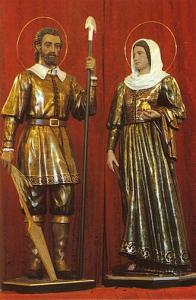
1130–1138: Papal schism, Non-Saint Pope # 164 Innocent II (February 14, 1130 – (September 24, 1143 -13 years, 222 days) vs. Antipope Anacletus II. The 1130 papal election (held February 14) was convoked after the death of Pope # 163 Non-Saint Honorius II (December 21, 1124 – February 13, 1130 – 5 years, 54 days) and resulted in a double election. Part of the cardinals, led by Cardinal-Chancellor Aymeric de la Chatre, elected Gregorio Papareschi as Pope Innocent II, but the rest of them refused to recognize him and elected Cardinal Pietro Pierleoni, who took the name of Anacletus II. Although Anacletus had the support of the majority of the cardinals, the Catholic Church considers Innocent II as the legitimate Pope, and Anacletus II as Antipope.
Somewhere between 1135–1154 – The legend of the green children of Woolpit concerns two children of unusual skin colour speaking an apparently unknown language who reportedly appeared in the village of Woolpit in Suffolk, England, sometime in the 12th century, perhaps during the reign of King Stephen.
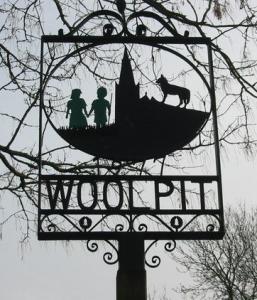
Village sign depicting the two green children of Woolpit, erected in 1977
The Green Child. The Green Child is the only completed novel by the English anarchist poet and critic Herbert Read. Written in 1934 and first published by Heinemann in 1935.

The Green Children of Woolpit The Green Children of Woolpit by J. Anderson Coats is published in 2019.
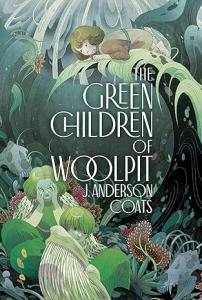
A Morbid Taste for Bones is a medieval mystery novel by Ellis Peters set in May 1137. It is the first novel in The Cadfael Chronicles, first published in 1977.
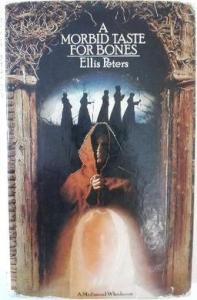
1139 – Catholic Ecumenical Council # 10: Second Lateran Council
It reaffirmed Lateran I and addressed clerical discipline (clerical celibacy, dress).One of the 29 canons of the council included banning the crossbow as a weapon.
It wasn’t explicitly crossbows that were prohibited, yet archery overall- and just against certain groups of Christians and Catholics. The Pope’s thinking appears to be clear. At that point, bows and arrows were the most productive strategy for killing enormous quantities of individuals, and the Pope thought it was unjustified for Christians to utilize it to target other Christians. -Muhammad Bilal Mahmood, Why Was the Crossbow Banned? | Savvy Crossbow
June 11, 1144– The Basilica of St. Denis near Paris is completed, and consecrated in the presence of Louis VII – as the first Gothic church.
December 1, 1045– Pope # 167 Bl.Eugene III (February 15, 1145 – July 8, 1153 – 8 years, 143 days) issues the bull Quantum praedecessores, calling for the Second Crusade. At Christmas, King Louis VII announces his intention of making a pilgrimage which becomes part of the Crusade.
1148: The illuminated manuscript Parc Abbey Bible was completed.
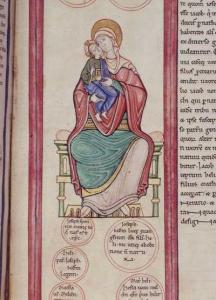
1152 – St. Dr. Hildegard von Bingen’s (c. 1098 – September 17, 1179) Scivias is written. Although the history of her formal canonization is complicated, regional calendars of the Roman Catholic Church have listed her as a saint for centuries. On May 10, 2012, Pope Benedict XVI extended the liturgical cult of Hildegard to the entire Catholic Church in a process known as “equivalent canonization“. On October 7, 2012, he named her a Doctor of the Church, in recognition of “her holiness of life and the originality of her teaching.
There are more surviving chants by Hildegard than by any other composer from the entire Middle Ages, and she is one of the few known composers to have written both the music and the words. One of her works, the Ordo Virtutum, is an early example of liturgical drama and arguably the oldest surviving morality play. She is noted for the invention of a constructed language known as Lingua Ignota. St. Stanislav Girls’ Choir of the Diocesan Classical Gymnasium is among the best European choirs led by charismatic conductor Helena Fojkar Zupančič. – youtube description
August 20, 1153 – Death of St. Dr. Bernard of Clairvaux. BOC 1090 – August 20, 1153), venerated as Saint Bernard, was an abbot, mystic, co-founder of the Knights Templar, and a major leader in the reformation of the Benedictine Order through the nascent Cistercian Order. He became a Doctor of the church in 1830. Before he died he wrote his spiritual classic ‘On Loving God’.
- Among us on the earth there is His memory; but in the Kingdom of heaven His very Presence. That Presence is the joy of those who have already attained to beatitude; the memory is the comfort of us who are still wayfarers, journeying towards the Fatherland.
- From, On Loving of God, Paul Halsall trans., Ch. 3
He also composed this hymn that is sung by Mormon’s in this video.
1160- Poet Marie de France (fl. 1160–1215) is born. She translated Aesop’s Fables from Middle English into Anglo-Norman French and wrote Legend of the Purgatory of St. Patrick, based upon a Latin text. Recently, she has been (tentatively) identified as the author of a saint’s life, The Life of Saint Audrey. published a large collection of fables. Many of the fables she wrote were translations of Aesop’s fables into English and others can be traced to more regional sources, fables to which Marie would have been exposed at a young age. Among her 102 fables, there are no concrete guidelines for morality; and men, women, and animals receive varying treatments and punishments. Fables (Toronto Medieval Texts & Translations) by Marie de France | Goodreads
1162 — Genghis Khan (1162 —August 25, 1227) founder and first khagan of the Mongol Empire, is born. He is known to have traveled in time with two dudes from the future in a traveling phone booth.
August 8, 1170 – St. Dominic, founder of the Dominican Order (d. 1221) is born.
December 29 1170– St. Thomas Becket is assassinated by four knights (who believe themselves to be carrying out Henry II’s wishes) in Canterbury Cathedral, after his refusal to be arrested for breaking his agreement with Henry II.
1170 – This is the earliest date for the making of Cheddar Cheese in Somerset (this according to a pipe roll of Henry II, who purchases 10,240 lb of Cheddar at a farthing per pound).
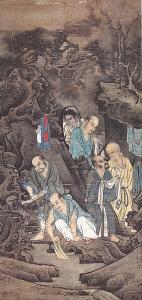
Luohan Laundering, by Lin Tinggui, 1178 AD
1179 – Catholic Ecumenical Council # 11: Third Lateran Council
It restricted papal election to the cardinals, condemned simony, and introduced minimum ages for ordination (thirty for bishops).
1181– St. Francis of Assisi (c. 1181 – 3 October 3, 1226) is born.
1185: First record of windmills.
July 4, 1187 – The Battle of Hattin was a battle in which the Muslim armies under Saladin captured or killed the vast majority of the Crusader forces, removing their capability to wage war. As a direct result of the battle, Muslims once again became the eminent military power in the Holy Land, re-capturing Jerusalem and most of the other Crusader-held cities and castles. These Christian defeats prompted the Third Crusade, which began two years after the Battle of Hattin.
1189–1192 –The Third Crusade (1189–1192) was an attempt led by three European monarchs of Western Christianity (Philip II of France, Richard I of England and Frederick I, Holy Roman Emperor) to reconquer the Holy Land following the capture of Jerusalem by the Ayyubid sultan Saladin in 1187. For this reason, the Third Crusade is also known as the Kings’ Crusade.
12th Century – “The Friendly Beasts” is a traditional Christmas song about the gifts that a donkey, cow, sheep, camel, and dove give to Jesus at the Nativity. The song seems to have originated in 12th-century France, set to the melody of the Latin song “Orientis Partibus”.
1191 – The Zen monk Eisai, founder of the Rinzai school of Buddhism, is generally credited for popularizing tea in Japan. When Eisai returned from a trip to China and brought back tea seeds which he planted on the island of Hirado and in the mountains of Kyushu.
January 8, 1198 – The Pontificate of Pope # 176 Non- Saint Innocent III (January 8, 1198 – July 16, 1216 – 18 years, 190 days) begins.
12th Century? – Merlin is a partly lost French epic poem written by Robert de Boron in Old French and dating from either the end of the 12th or beginning of the 13th century. The author reworked Geoffrey of Monmouth‘s material on the legendary Merlin, emphasising Merlin’s power to prophesy and linking him to the Holy Grail. The poem tells of his origin and early life as a redeemed Antichrist, his role in the birth of Arthur, and how Arthur became King of Britain
Thus ends our look at the first two centuries of the 2nd millenium.
NEXT TIME ON
HOARATS
To Understand
What I love and How I Write About History
Hit the Link Above.
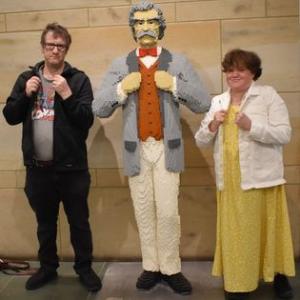
To understand about this particular series I’m writing about, please read
The Catholic Bard’s Guide To History Introduction
And to view a historical article click on


